NCERT Solutions for Class 6 Science Chapter 9 Electricity And Circuits are available here with free PDF. These solutions include answers to all exercise questions given in the NCERT textbook. NCERT solutions for class 6 science Chapter 9 contains various type of questions like match the following, fill in the blanks, MCQ and long answer questions.
All these solutions are prepared by expert teachers with detailed explanations of every important topic. It is important for the students to go through these NCERT solutions to get knowledge of the type of question asked in the chapter.
Class 6 Science Chapter 9 Electricity And Circuits Questions and Answers
Exercise Questions
Question 1. Fill in the blanks:
(a) A device that is used to break an electric circuit is called_______________
(b) An electric cell has___________
Answer:
(a) switch
(b) two
Question 2. Mark ‘True’ or ‘False’ for the following statements:
(a) Electric current can flow through metals.
(b) Instead of metal wires, a jute string can be used to make a circuit.
(c) Electric current can pass through a sheet of thermocol.
Answer:
(a) True
(b) False
(c) False.
Question 3: Explain why the bulb would not glow in the arrangement shown in Fig. 12.13.
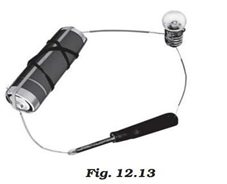
Answer: The handle of screw driver is made up of insulator, which does not allow the current to flow. That is why the bulb is not glowing.
Question 4: Complete the drawing shown in Fig 12.14 to indicate where the free ends of the two wires should be joined to make the bulb glow.
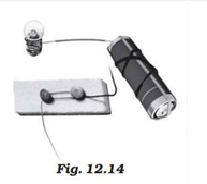
Answer:
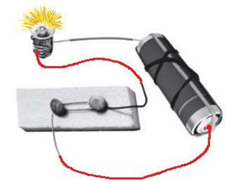
Question 5: What is the purpose of using an electric switch? Name some electrical gadgets that have switches built into them.
Answer: Purpose of the electric switch is to complete or break the circuit. The switches used in the lighting of electric bulbs and other devices in homes work on the same principle. Electrical gadgets that have switches built into them are Fan, refrigerator, television, microwave oven, electric cookers.
Question 6: Would the bulb glow after completing the circuit shown in Fig. 12.14 if instead of safety pin we use an eraser?
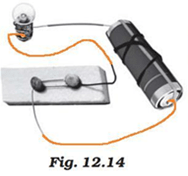
Answer: Eraser is an insulator, so the circuit will not complete. As a result, the bulb will not glow.
Question 7: Would the bulb glow in the circuit shown in Fig. 12.15?
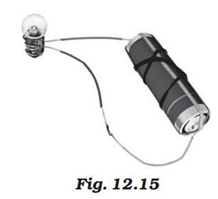
Answer: Both the wire are connected to only one terminal of the bulb, so current will not flow through the bulb and it would not glow. We should make a correction as follows:
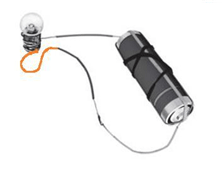
Question 8: Using the “conduction tester” on an object it was found that the bulb begins to glow. Is that object a conductor or an insulator? Explain.
Answer: Since the object allows current to flow and completes the circuit and makes bulb to glow. It means the object is a conductor of electricity.
Question 9: Why should an electrician use rubber gloves while repairing an electric switch at your home? Explain.
Answer: Electricians frequently touch copper wires or they may accidentally come in contact with live wires (wires carrying current). Since human body is a good conductor, electricians may get shock. Rubber is an insulator. To prevent themselves from electric shock or flow of current, the electricians use rubber gloves while repairing.
Question 10: The handles of the tools like screwdrivers and pliers used by electricians for repair work usually have plastic or rubber covers on them. Can you explain why?
Answer: Without the help of insulators, the use of electrical tools like pliers and screwdrivers will give electric shock to user. Wood and plastics are insulators and help in avoiding direct contact with electric current. When electricians touch these live electric wires with these tools covered with plastic or rubber, current does not flow in their body making safer them from any accident.
Class 6 Science Chapter 9 Electricity And Circuits Extra Questions
Class 6 Science Chapter 9 Electricity And Circuits From Extra Questions section includes multiple choice questions (MCQs), short and answer type questions etc. All these questions are very important from examination point of view.
Extra Questions
Multiple Choice Questions (MCQs)
(i) Cell is a device which
(a) converts chemical energy into electrical energy
(b) electrical energy into light energy
(c) electrical energy into magnetic energy
(d) None of these
Answer: (a) converts chemical energy into electrical energy
(ii) A bulb has
(a) two terminals and one filament
(b) two terminals and two filaments
(c) multiple terminals and single filament
(d) single terminal and single filament
Answer: (a) two terminals and one filament
(iii) Filament of a bulb is made up of
(a) aluminium
(b) chromium
(c) platinum
(d) tungsten
Answer: (d) tungsten
(iv) Bulb glows only in
(a) closed circuit
(b) open circuit
(c) in both circuits
(d) open circuit if bulb is not fused
Answer: (a) closed circuit
(v) A battery is
(a) a single cell
(b) a combination of cells in which cells are joined (+) to (-)
(c) a combination of cells in which cells are joined (+) to (+)
(d) None of these
Answer: (b) a combination of cells in which cells are joined (+) to (-)
(vi) A substance which do not allow electricity to pass through it is called
(a) a conductor
(b) an insulator
(c) semiconductor
(d) superconductor
Answer: (b) an insulator
(vii) Which is an example of an insulator
(a) bakelite
(b) aluminium
(c) tap water
(d) All of these
Answer: (b) aluminium
(viii) An example of a conductor is
(a) tap water
(b) salt solution
(c) metal wire
(d) all of these
Answer: (d) all of these
(ix) How many terminals are there in a dry cell?
(a) One
(b) Two
(c) Three
(d) Four
Answer: (b) Two
(x) To prevent electric shocks, the metallic electrical wires are covered with
(a) paper
(b) cotton
(c) aluminium
(d) plastic
Answer: (d) Plastic
Short Type Answer and Questions
Question 1. What is an electric cell?
Answer: Electric cell is a source of energy. It produces a small amount of electricity from chemicals stored inside it.
Question 2. What is meant by a battery?
Answer: When two or more cells are joined together, it is called a battery.
Question 3. Give any difference between a cell and a battery.
Answer: A cell has only one plate as a positive and only one plate as a negative electrode, while a battery, which is a combination of cells in a series, can have many plates.
Question 4. Why does a cell stop producing electricity after some time?
Answer: An electric cell produces electricity from chemicals stored inside it. When the chemicals inside the cell are used up, the cell stops producing electricity.
Question 5. Why should we not join the wires connected to the two terminals of the electric cell?
Answer: We should never join the wires with two terminals of the electric cell. If we do so, the chemicals in the electric cell get used up very fast and the cell stops working.
Question 6. Name some devices in which we use an electric cell.
Answer: We use electric cell in an alarm clock, wrist watch, transistor, camera, torch, etc.
Question 7. Two cells can be joined in two ways in series and in parallel. What do you mean by these two ways? In which way the cells are joined in a torch?
Answer: Series connection: When (+) terminal of one cell is joined to (-) terminal of the other, the arrangement is called series connection.
Parallel connection: When (+) terminal of a cell is joined to (+) terminal and (-) terminal to (-) terminal of another cell, the arrangement is called in parallel connection.
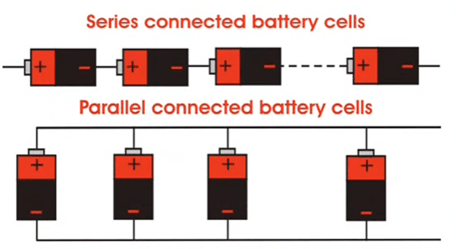
Question 8. Why shouldn’t the two terminals of an electric cell be joined directly?
Answer: Never join the two terminals of the electric cell without connecting them through a switch and a device like a bulb: Because if you do so, the chemicals in the electric cell get used up very fast and the cell stops working.
Question 9. How do we connect wires to the electric cell?
Answer: Two separate wires are connected to the two terminals of the cell as shown below:
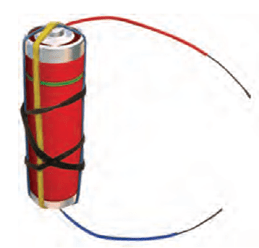
Question 10. How is the bulb connected to the wires?
Answer: We can stick the wires to the bulb at the two terminals by the tape or using soldering machine as shown in the figure.
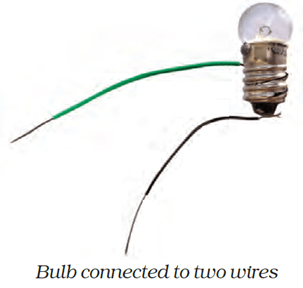
Question 11. How is an electric bulb connected to the cell? Show by a diagram.
Answer:
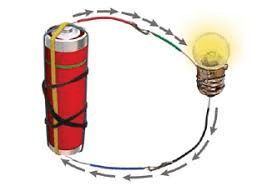
Question 12. What are the advantages of dry cells?
Answer: Advantages of dry cells are:
- They are light in weight and small in size.
- They can be transported from one place to another easily.
- There is no fear of leakage/spillage in dry cells.
Question 13. What is electric circuit?
Answer: Path from one terminal of the electric cell to the other terminal of the electric cell through wires passing to and from the electric bulb is called electric circuit.
Question 14. What is the direction of the current in the electric circuit?
Answer: In an electric circuit, the direction of current is taken to be from the positive terminal to the negative terminal of the electric cell.
Question 15. Sometimes an electric bulb does not glow even if it is connected to the cell. What could be the reason?
Answer: This may happen if the bulb has fused.
Question 16. What is a filament?
Answer: A filament is a thin wire fixed in the middle of a bulb connected to the two supporting wires.
Question 17. Why does a fused bulb not light up?
Answer: A fused bulb means a break in its filament which results in a break in the path of the current between the terminals of the electric cell. Thus a fused bulb does not light up as no current passes through its filament.
Question 18. What is the purpose of using an electric switch? Name some electrical gadgets that have switches built into them.
Answer: A switch is a simple device that either breaks the circuit or completes it. Hence we use electric switches in order to either
- stop an electrical gadget in function when required, or
- start an electrical gadget when needed.
Some electrical gadgets that have switches built into them are—electric iron, table fan, television set, radio, etc.
Question 19. How are cells arranged in a torch—in parallel or in series?
Answer: In torch, cells are connected in series.
Question 20. If in a circuit you have arranged cells in series. Will the bulb continue to shine even if the connection of one of the cells is reversed?
Answer: If cells are connected in a series in a circuit, change of ends of any one of the cells will stop the flow of electricity and the bulb might not illuminate as circuit will not be completed.
Question 21. Give the symbol of following:
- Cell
- Battery
- Lamp
- Switch (OFF)
- Switch (ON)
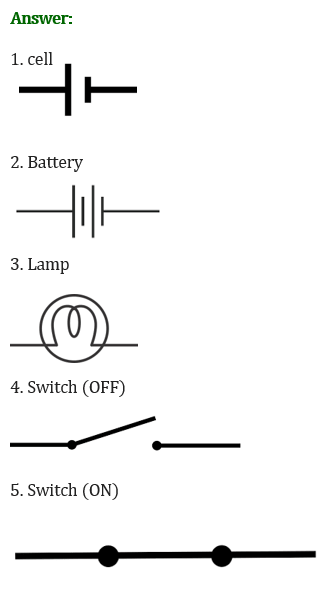
Question 22. What is a conductor? Give examples.
Answer: A conductor is a material that allows an electric current to pass through it. For example, copper, aluminium, zinc, iron, etc.
Question 23. What is an insulator? Give few examples.
Answer: Insulator is the material that does not allow an electric current to pass through it. For example, wood, mica, asbestos, rubber, etc.
Question 24. Why does one remove the plastic coating of connecting wires before making circuits?
Answer: Plastics is a bad conductor or insulator of electricity. It prevents us from electric shocks. To complete the circuit, we have to remove the plastic coating to connect wires so that the current may flow through the circuit.
Question 25. Why do you have to clean the ends of wires used for making a circuit with sand paper to make the bulbs shine?
Answer: A layer of bad conductor polish is coated on the wire. The current will flow properly after removing this coat. Therefore, we have to remove the coating with sand paper.
Question 26. Is our body insulator or conductor?
Answer: Our body is a good conductor of electricity.
Long Type Answer Questions
Question 1. Is air a good or a bad conductor of electricity?
Answer: Air is a bad conductor of electricity. If air were the good conductor of electricity, electricity could reach to the bulb without wiring and the bulb could light without wires. Moreover, the electricity running through wire could scatter all around the wire and then it might be dangerous.
Question 2. What would happen if air were a good conductor of electricity?
Answer: If air were a good conductor of electricity, the electricity could scatter all around in atmosphere nearby the power stations. The men at work could die with electric shocks. The electricity could not be transmitted to homes, factories from power stations.
Question 3. Out of aluminium foil, paper, dry cloth and rubber sheet, which is the good conductor? Tell by using a torch.
Answer: Aluminium is a good conductor of heat and electricity. For this explanation, take a torch with cells. Switch on to see that it lights up. Now in the place between the bulb and the cell put all things like aluminium foil, dry cloth and rubber sheet one by one and check whether the torch lights up. It lights up with aluminium foil only. So, we can say that aluminium is a good conductor.
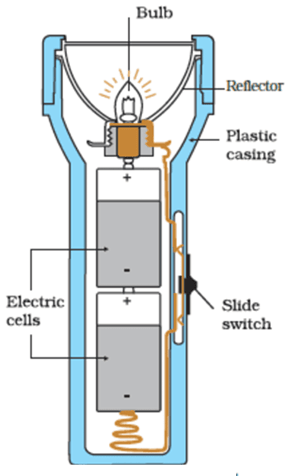
Question 4. Give some uses of conductors and insulators.
Answer: Conductors and insulators are equally important for us. Switches, electrical plugs and sockets are made of conductors. On the other hand, rubber and plastic are used for covering the electrical wires, plug tops, switches and other parts of electrical appliances, which people might touch.
Question 5. Why is the handle of electrician’s screw driver made of plastic?
Answer: A screw driver is made of steel. It is a good conductor of electricity. So electricity can easily flow through it. Plastic is a bad conductor and does not allow electricity to pass through it. So, the electrician has a plastic handle to protect him from any shock.
Question 6. Using a conduction tester, select conductors and insulators from the following. Note your observations in a table as follows:
Pin, notebook, chalk, duster, pen, comb, key, rubber, nail, paper.
| S. No. | Thing | Bulb blows are not | Circuit Situation | Object is conduct / insulator |
| 1. | ||||
| 2. |
Answer:
| Sl. No. | Thing | Bulb glows or not | Circuit situation | Object is conductor/ insulator |
| 1. | Pin | Bulb glows | Circuit is complete | Conductor |
| 2. | Notebook | Bulb doesn’t glow | Circuit is not complete | Insulator |
| 3. | Chalk | Bulb doesn’t glow | Circuit is not complete | Insulator |
| 4. | Duster | Bulb doesn’t glow | Circuit is not complete – | Insulator |
| 5. | Pen | Bulb doesn’t glow | Circuit is not complete | Insulator |
| 6. | Comb | Bulb doesn’t glow | Circuit is not complete | Insulator |
| 7. | Key | Bulb glows | Circuit is complete | Conductor |
| 8. | Rubber | Bulb doesn’t glow | Circuit is not complete | Insulator |
| 9. | Nail | Bulb glows | Circuit is complete | Conductor |
| 10. | Paper | Bulb doesn’t glow | Circuit is not complete | Insulator |
Question 7. What is power station? What are its types?
Answer: The electricity used by us in our homes is supplied from power stations. Types of power station:
- Hydro power station
- Thermal power station
- Solar power station
- Nuclear power station.
Question 8. Match the following items given in Column A with that in Column B:
| Column A | Column B |
| (a) Cell | (i) Allows electricity to pass through it |
| (b) Battery | (ii) Either breaks or completes a circuit |
| (c) Conductor | (iii) Converts electricity into light |
| (d) Insulator | (iv) Glows when electricity passes in it |
| (e) Switch | (v) A device which produces electricity |
| (f) Bulb | (vi) Is a path of electricity |
| (g) Filament | (vii) Does not allow electricity to pass |
| (h) Circuit | (viii) A combination of cells |
Answer:
| Column A | Column B |
| (a) Cell | (v) A device which produces electricity |
| (b) Battery | (viii) A combination of cells |
| (c) Conductor | (i) Allows electricity to pass through it |
| (d) Insulator | (vii) Does not allow electricity to pass |
| (e) Switch | (ii) in Either breaks or completes a circuit |
| (f) Bulb | (iii) Converts electricity into light |
| (g) Filament | (iv) Glows when electricity passes in it |
| (h) Circuit | (vi) Is a path of electricity |